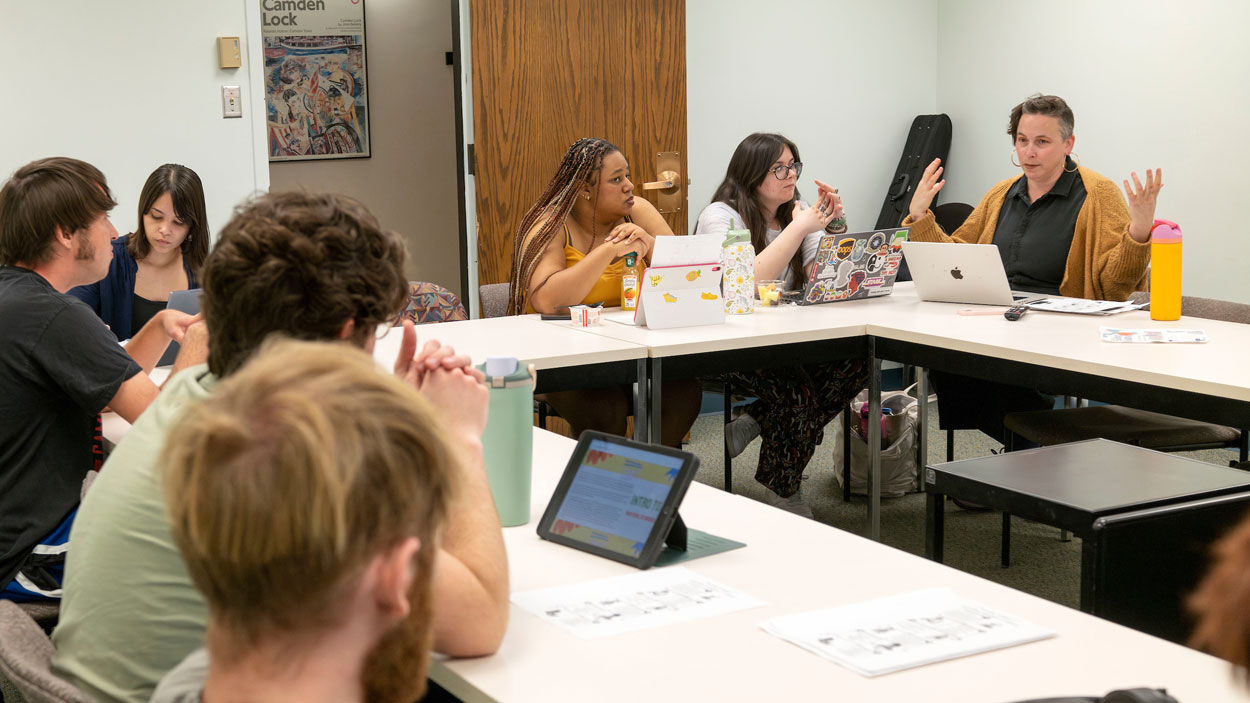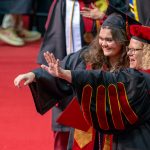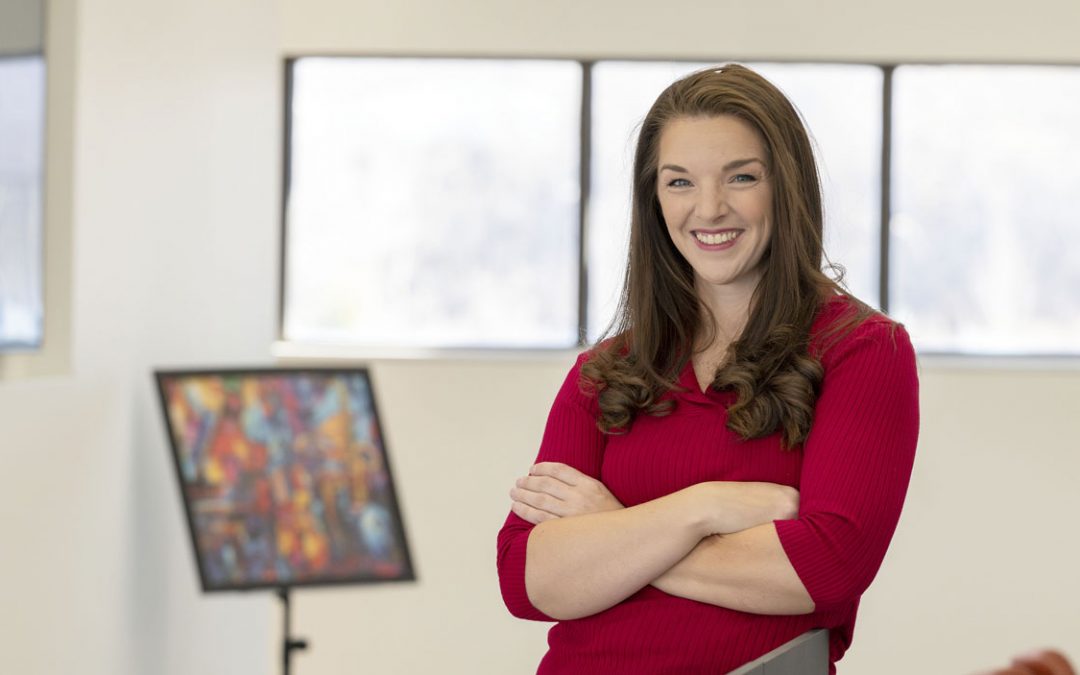
Associate Professor Lauren Obermark (top right) leads a discussion in her English 2400 course. Obermark recently worked with Assistant Teaching Professor Lauren Terbrock-Elmestad to reimagine the curriculum of English 1100, UMSL’s first-year writing course. (Photo by Derik Holtmann)
Writing is a fundamental element of academic success, but it’s more than that as well. It’s a crucial medium for self-expression, reaching into areas of students’ lives beyond school. Every student is a writer in one way or another, even if they occasionally need to be reminded of it.
Associate Professor Lauren Obermark and Assistant Teaching Professor Lauren Terbrock-Elmestad kept this simple truth in mind when they set out to revamp English 1100, the required first-year writing course, at the University of Missouri–St. Louis.
“I don’t know how many students come into first-year writing with a story about how they used to love to journal, and then around high school, they stopped journaling because writing became a chore,” Terbrock-Elmestad said. “We’re getting them to remember what writing can do for them, not only academically but also personally.”
In addition to their roles as faculty members in the Department of English, Obermark and Terbrock-Elmestad officially assumed positions as co-administrators of the UMSL English Writing Program at the beginning of the fall semester. Last summer, the pair worked to update the curriculum of UMSL’s first-year writing course, a general education requirement, which they piloted during the fall semester and fully implemented this semester.
Obermark and Terbrock-Elmestad are exploring updates to elements of 3000-level writing courses, a graduation requirement for transfer students, as well. They are also utilizing a course enrichment grant from the College of Arts and Sciences to launch a digital journal to showcase students’ class work and to host writing workshops and speaking events with writers directed at students, staff and faculty members.
These efforts are all aimed at fostering an environment where writing is celebrated and thrives across academic units.
“We want to strengthen the culture of writing across the UMSL campus overall,” Obermark said. “We want to think about what an English department writing program can bring to the campus more generally, as writing is such a key part of universities in so many different ways.”
A solid foundation
Most U.S. colleges and universities require students to take some sort of writing composition course. At UMSL, many first-year students take English 1100, while juniors take one of four 3000-level courses. Options for the latter include classes such as business writing and science writing.
The idea behind these requirements is to create a solid foundation for students as they progress through their degree programs. These courses teach students how to analyze texts, synthesize information, develop and support an argument and, ultimately, communicate their ideas effectively.
“The bigger goals of writing classes and the writing program here are that students are practicing and learning these processes that they can take into other classes and varied disciplines,” Obermark said. “If we’re learning about using sources, how they can apply what they learn about putting sources in conversation with each other into something that they might work on in a chemistry class that would still require them to do some kind of original research situated in scholarly conversation.”
Obermark and Terbrock-Elmestad recognized that the curriculum and structure of the first-year writing course had remained relatively consistent for years. As new co-administrators of the UMSL English Writing Program, they saw an opportunity to build a fresh curriculum that let students build writing confidence and experiment with a variety of research, genres and technology.
Writing levels
The first thing Obermark and Terbrock-Elmestad did was collaborate with teaching assistants who had previously taught the course. In an average semester, there might be 20 sections of the first-year writing course, so TAs are indispensable in the effort to instruct that many students. They were able to identify the areas where students were succeeding and where others were struggling.
“We looked at the outcomes that we have to use for the course and then also thought about the softer things that we wanted for writers – to have space to practice, to think about self-expression, to build confidence, to see themselves as writers,” Obermark said.
Those student outcomes are a handful of touchstones that guide what students will be able to do after completing the course. For example, students should be able to analyze, synthesize and interpret different ideas and information. They should also be able to use multiple composition strategies to develop and complete a comprehensive final project.
With those benchmarks in mind, Obermark also wanted to underscore the idea that writing matters at personal, university and community levels. The new structure of the course reflects this. Students spend the first two weeks on a literacy reflection, a personal narrative on their experiences with reading and writing. The assignment helps them get situated in the course and spurs them to think about what it means to be a writer.
From there, they move on to an academic synthesis essay, which emphasizes the importance of writing at the university level. Students select a topic and multiple texts from a digital bookshelf and then put those sources in conversation with each other, comparing and contrasting the ideas presented.
The next step is thinking about how writing matters in communities. It’s the portion of the class students spend the most time on, and it’s the aspect Obermark and Terbrock-Elmestad are most excited about. It consists of a final community advocacy project, where students research a local issue they want to address. They review existing research and literature on the issue and also conduct primary research such as interviews, field observations or surveys. Ultimately, students present their findings and proposed solutions via some sort of digital platform, typically a website.
The sequence of the assignments illustrates how the impact of writing ripples outward.
“It was important to me that there was a trajectory that students could see,” Obermark said. “They could see the ways all the different assignments in the class fit together. We have this arc we’re following.”
Buy-in from students
Most sections of the course piloted the new curriculum in the fall semester, and this semester, every section implemented it. Thus far, instructors of the course have seen buy-in from students, who have been particularly engaged during the community advocacy project. They attribute this success, in part, to students’ ability to pick texts and topics that interest them and to try different forms of writing.
“They get really excited when they can write for an audience or for a reason that is not just instructor-specific,” Terbrock-Elmestad said. “When you are writing an academic essay, usually no one’s going to see it except the instructor. When you add in the components of, ‘I’m going to be sharing this with my classmates,’ ‘I am going to be putting this information onto a website that’s going to be public-facing,’ the buy-in shifts. They get to see how their ideas and how their writing can have different effects on different audiences.”
Terbrock-Elmestad added that the class schedule builds in time for both research and revision, which is essential for any writing course. That time allows students to focus on the full process of writing – not just the end result.
“I like to think of my classrooms as laboratories of sorts,” she said. “I want to give them time and space to play with writing. When you go into other classes, you’re given a writing assignment. This is the essay that you need to write and then are supposed to go sit in your dorm room or your apartment in front of a blank screen, write the essay, turn it in and then you get a grade on it. There’s a lot that happens in the lead up to that act. That act of sitting down to write an essay. So, this writing class serves as a space to go, ‘I’m coming up with ideas. I’m changing my ideas, I’m doing some research.’”
Cross-campus support
Obermark and Terbrock-Elmestad have worked to build campus partnerships into the first-year writing course, as well.
UMSL Writing Center staff members come to the classroom to encourage students to take advantage of the center’s services. Librarians from University Libraries have also presented on research methods, and students take a mini field trip to the State Historical Society of Missouri’s St. Louis research center in the Thomas Jefferson Library. The UMSL Digital Humanities Lab offers workshops on digital tools for multimodal writing, as well.
The pair have also utilized a course enrichment grant to start a speakers series titled, “Writers Talk Writing.” The events feature two writers connected to UMSL who discuss their writing processes and quirks, and they are open to the UMSL community. The next one will be held on April 22. The same grant will also go toward establishing a digital journal to preserve and showcase the work of first-year writing students.
“We’re the English Writing Program, but I think the overarching goal in all of this is to cultivate a culture of writing all the way across the university, so that writing isn’t something that only happens in the English Department,” Terbrock-Elmestad said. “Writing is happening all over campus in a variety of ways. So, how can we support that writing at every level? I think that’s really where our efforts are.”














